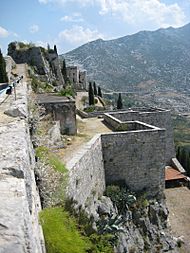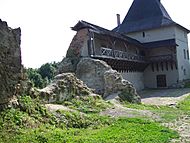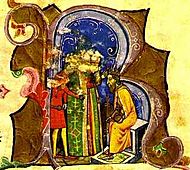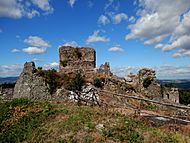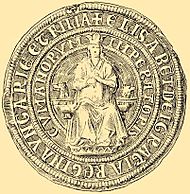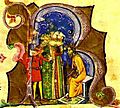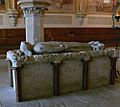Béla IV of Hungary facts for kids
Quick facts for kids Béla IV |
|
|---|---|
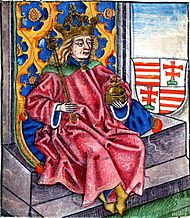 |
|
| King of Hungary and Croatia | |
| Reign | 21 September 1235 – 3 May 1270 |
| Coronation | 1214 14 October 1235 |
| Predecessor | Andrew II |
| Successor | Stephen V |
| Duke of Styria | |
| Reign | 1254–1258 |
| Predecessor | Ottokar V |
| Successor | Stephen |
| Born | 1206 |
| Died | 3 May 1270 (aged 63–64) Rabbits' Island, Budapest |
| Burial | Minorites' Church, Esztergom |
| Spouse |
Maria Laskarina
(m. 1235) |
| Issue more... |
|
| Dynasty | Árpád dynasty |
| Father | Andrew II of Hungary |
| Mother | Gertrude of Merania |
| Religion | Roman Catholic |
Béla IV (born 1206 – died 3 May 1270) was an important King of Hungary and Croatia. He ruled from 1235 to 1270. He was also the Duke of Styria for a few years (1254–1258). Béla was the oldest son of King Andrew II. He was crowned king in 1214, even while his father was still alive.
At first, his father didn't give him a region to rule. But in 1220, Béla became the Duke of Slavonia, which included parts of Croatia and Dalmatia. Around this time, he married Maria Laskarina, a princess from Nicaea. From 1226, he governed Transylvania as its duke. He helped Christian missionaries work among the Cumans, a group of people living east of his lands. Some Cuman leaders accepted his rule, and he even called himself King of Cumania in 1233.
When King Andrew died in 1235, Béla became the full king. He tried to make the king's power stronger again, as it had become weaker under his father. He took back some lands that had been given away, which made many noblemen and church leaders unhappy.
A huge challenge came when the Mongols invaded Hungary. They destroyed Béla's army in the Battle of Mohi on 11 April 1241. Béla managed to escape, but the Mongols chased him all the way to Trogir on the Adriatic Sea coast. The Mongols devastated the country before they suddenly left in March 1242.
After this terrible invasion, Béla made big changes to prepare for another possible Mongol attack. He allowed his powerful lords and church leaders to build strong stone castles and create their own armies. He also encouraged the growth of fortified towns. Thousands of new settlers came from other countries to live in the empty lands. Béla's hard work to rebuild his country earned him the title "second founder of the state."
He formed alliances against the Mongols with rulers like Daniil Romanovich of Halych and Bolesław V the Chaste of Cracow. These allies helped him take over the Duchy of Styria in 1254, but he lost it six years later. During his reign, Béla also created a strong defense zone along Hungary's southern border.
Later in his reign, Béla had disagreements with his oldest son, Stephen. This was because Béla seemed to favor his daughter Anna and his youngest son, Béla, Duke of Slavonia. Eventually, Béla had to give Stephen control over the eastern parts of Hungary. This led to a civil war that lasted until 1266.
Béla's family was known for being very religious. He himself became a Franciscan follower. Three of his daughters—Kunigunda, Yolanda, and Margaret—were later recognized as saints by the Church.
Contents
Early Life (1206–1220)
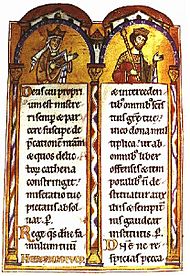
Béla was born in the second half of 1206. He was the first son of King Andrew II of Hungary and his first wife, Gertrude of Merania. Even before Béla was born, Pope Innocent III asked Hungarian leaders to promise loyalty to the future prince.
Queen Gertrude showed special favor to her German relatives. This made many Hungarian nobles unhappy. In 1213, while King Andrew was away fighting, some angry nobles captured and killed Queen Gertrude. King Andrew only punished one of the plotters when he returned. Even though Béla was young, he never forgot his mother and always spoke of his respect for her.
In 1214, King Andrew asked the Pope to stop some lords who wanted to crown Béla king. But the eight-year-old Béla was crowned anyway that same year. However, his father did not give him a region to rule. When King Andrew left for a Crusade in 1217, he appointed someone else to rule in his place. During this time, Béla stayed with his uncle in the Holy Roman Empire.
King Andrew returned in 1218. He arranged for Béla to marry Maria Laskarina, the daughter of the Emperor of Nicaea. Maria came to Hungary with the King, and Béla married her in 1220.
Young King (Rex Iunior)
Duke of Slavonia (1220–1226)
In 1220, King Andrew gave Béla control over the lands between the Adriatic Sea and the Dráva River. These lands included Croatia, Dalmatia, and Slavonia. A letter from the Pope in 1222 shows that some people forced King Andrew to share his power with Béla. At first, Béla called himself "King Andrew's son and King." Later, he used the title "King, by the Grace of God, son of the King of Hungary, and Duke of all Slavonia."
In 1222, Béla separated from his wife because his father demanded it. But the Pope said the marriage was legal. Béla accepted the Pope's decision and went to Austria to escape his father's anger. He returned with his wife in 1223 after church leaders convinced his father to forgive him. Back in Slavonia, Béla fought against a rebellious nobleman and captured his fortress at Klis.
Duke of Transylvania (1226–1235)
In 1226, King Andrew moved Béla from Slavonia to Transylvania. Béla's brother, Coloman, took over as Duke of Slavonia. As Duke of Transylvania, Béla wanted to expand his rule into lands beyond the Carpathian Mountains. He supported the Dominican monks who were trying to convert the Cumans to Christianity.
In 1227, Béla crossed the mountains and met a Cuman leader named Boricius. Boricius and his people decided to become Christians and accepted Béla as their ruler. Within a year, a new Catholic church area was set up in their lands.
Béla believed that his father's habit of giving away royal lands was weakening the kingdom. So, in 1228, he started taking back some of these lands. The Pope supported Béla, but King Andrew often made it hard for his son to do this. Béla also took lands from two noblemen who had plotted against his mother.
Béla's youngest brother, Andrew, was driven out of his principality in 1229. Béla decided to help him get his throne back. He proudly said that the town of Halych would be destroyed if it didn't surrender. Béla crossed the Carpathian Mountains and attacked Halych with his Cuman allies. However, he could not capture the town and had to retreat. Many Hungarian soldiers died on their way home.
Béla also invaded Bulgaria and attacked Vidin in 1228 or 1232, but he could not take the fortress. Around the same time, he created a new border region called the Banate of Szörény. In 1233, Béla took the title "King of Cumania" to show his power in the lands east of the Carpathians. He also supported a monk named Friar Julian, who traveled to find the descendants of Hungarians who had stayed in their ancient homeland.
Béla's Reign
Before the Mongol Invasion (1235–1241)
King Andrew died on 21 September 1235. Béla became king without any problems and was crowned in Székesfehérvár on 14 October. He removed and punished many of his father's closest advisors.
Béla announced that his main goal was to bring back the king's power and restore the country to how it was under his grandfather, Béla III. One writer said that Béla even burned the chairs of the nobles to make them stand in his presence. Béla created special groups to check all the land grants made since 1196. Taking back these lands made many people angry. The Pope also complained when Béla took back lands given to some religious groups. In 1239, Béla agreed to stop taking back lands from these groups. In return, the Pope allowed him to use Jewish and Muslim people in his government's money matters.
In 1236, Friar Julian returned from his journey and told Béla about the Mongols. They had reached the Volga River and planned to invade Europe. The Mongols defeated the Cumans, and at least 40,000 Cumans came to Hungary's eastern border in 1239. They asked for shelter. Béla agreed, but only after their leader, Köten, promised that his people would become Christians and fight the Mongols.
However, settling so many nomadic Cumans in Hungary caused many problems with the local villagers. Béla needed the Cumans' military help, so he rarely punished them for their crimes. His Hungarian subjects thought he favored the Cumans, which caused "enmity between the people and the king."
Béla also helped towns grow. For example, he confirmed the special rights of the people of Székesfehérvár. He also gave privileges to Hungarian and German settlers in Bars in 1237. Zadar, a town in Dalmatia that had been lost to Venice, accepted Béla's rule in 1240.
Mongol Invasion of Hungary (1241–1242)
The Mongols gathered near Hungary and Poland in December 1240, led by Batu Khan. They demanded that Béla surrender to their leader, Ögödei. Béla refused and had the mountain passes guarded. But the Mongols broke through the defenses on 12 March 1241.
Duke Frederick II of Austria came to help Béla. He defeated a small Mongol group near Pest. He captured some prisoners, including Cumans who had been forced to join the Mongols. When people in Pest saw Cumans in the Mongol army, they panicked. They accused Köten and his Cumans of working with the enemy. A riot broke out, and Köten's followers were killed. Köten himself died. When the Cumans heard this, they left Hungary, destroying many villages as they went.
With the Cumans gone, Béla lost important allies. He could only gather an army of less than 60,000 soldiers. His army was not ready, and some of his commanders, who were angry with Béla, hoped he would lose. The Hungarian army was almost completely destroyed in the Battle of Mohi on 11 April 1241. Many Hungarian lords, church leaders, and nobles died. Béla barely escaped the battlefield. He fled through Nyitra to Pressburg (now Bratislava). The Mongols took over and ruined most of the lands east of the Danube River by June.
Béla went to Austria, but Duke Frederick II forced him to give up three counties instead of helping him. From there, Béla fled to Zagreb. He sent letters to the Pope and other European rulers, asking for help. He even accepted the Emperor's rule in June, hoping for military aid. The Pope called for a Crusade against the Mongols, but no help arrived.
The Mongols crossed the frozen Danube in early 1242. A Mongol group chased Béla through Dalmatia. Béla found safety in the strong fortress of Trogir. Before the Mongols could attack Trogir, news arrived that their Great Khan had died. Batu Khan wanted to return for the election of a new leader, so he ordered all Mongol forces to leave. Béla was very thankful to Trogir and gave it lands, which caused a long conflict between Trogir and Split.
"Second Founder of the State" (1242–1261)
When Béla returned to Hungary in May 1242, he found a ruined country. The plains east of the Danube were especially damaged, with at least half of the villages empty. The Mongols had destroyed most old administrative centers, which had only wooden walls. Only strong places like Esztergom and Székesfehérvár had survived. A severe famine followed in 1242 and 1243.
Preparing for another Mongol invasion became Béla's main focus. In 1247, he told the Pope about his plan to strengthen the Danube River with new forts. He changed an old rule, allowing nobles and church leaders to build their own castles. Nearly 100 new fortresses were built by the end of his reign. These included new castles at Nagysáros (now Veľký Šariš, Slovakia) and Visegrád.
Béla also tried to increase his army's size and improve its equipment. He gave land to people in forested areas, making them promise to provide heavily armed horsemen for the royal army. He even allowed powerful lords to have their own armed followers, who used to report directly to the king. In 1247, Béla gave the Banate of Szörény to the Knights Hospitaller, but they left the region by 1260.
To make up for the population loss from the invasion and famine, Béla encouraged new settlers. He gave special freedoms to these colonists, including personal freedom and lower taxes. Germans, Poles, and others came from neighboring countries to settle in empty areas. He also convinced the Cumans, who had left in 1241, to return and settle in Hungary. He even arranged for his oldest son, Stephen, to marry Elisabeth, the daughter of a Cuman chieftain. Stephen was crowned junior king around 1246.
Béla gave special rights to over 20 settlements, helping them grow into self-governing towns. He also set out the rights for mining towns in Upper Hungary. For defense, he moved the people of Pest to a hill on the other side of the Danube in 1248. This new fortified town, Buda, became a major trade center within 20 years. Béla also gave special rights to Gradec (part of Zagreb) in 1242 and confirmed them in 1266.
Béla started an active foreign policy after the Mongols left. In 1242, he invaded Austria and forced Duke Frederick II to give back the three counties he had taken. However, Venice took Zadar in 1243. Béla gave up his claim to Zadar in 1244, but Venice agreed to give him a third of the town's customs revenues.
Béla created a defense alliance against the Mongols. He married three of his daughters to princes whose countries were also threatened. Rostislav Mikhailovich, a prince from Halych, married Béla's daughter Anna in 1243. Béla helped Rostislav invade Halych in 1245, but they were defeated.
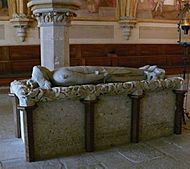
In 1245, the Pope released Béla from his promise of loyalty to Emperor Frederick. The next year, Duke Frederick II of Austria invaded Hungary. He defeated Béla's army in the Battle of the Leitha River in 1246, but he died in the battle. His death led to conflicts over who would rule Austria and Styria. Béla decided to get involved after the threat of another Mongol invasion lessened. In 1250, Béla attacked Austria and Styria. That same year, he made peace with Daniil Romanovich of Halych. With Béla's help, Daniil's son married Frederick's niece.
Béla and Daniil Romanovich invaded Austria and Moravia in 1252. After they left, Ottokar, who had married Frederick's sister, took over Austria and Styria. In 1253, Béla attacked Moravia and besieged Olomouc. He lifted the siege in June. The Pope helped create a peace treaty in 1254. Under this treaty, Ottokar, who was now King of Bohemia, gave Styria to Béla.
Béla appointed his son-in-law, Rostislav Mikhailovich, as the leader of Banate of Macsó in 1254. Rostislav's job was to create a buffer zone along the southern borders. He invaded Bosnia and forced the Bulgarian Tzar to give up Belgrade and Barancs in 1255. Béla sometimes used the title "King of Bulgaria."
The nobles in Styria rebelled against Béla's governor in 1258. Béla invaded Styria, restored his rule, and made his oldest son, Stephen, the Duke of Styria. In 1259, a Mongol leader offered an alliance, but Béla refused.
The Styrian lords were unhappy with Béla's son and asked Ottokar of Bohemia for help. Béla and his allies invaded Moravia, but Ottokar defeated them in the Battle of Kressenbrunn in 1260. This defeat forced Béla to give up Styria to the King of Bohemia in the Peace of Vienna in 1261. Ottokar then divorced his old wife and married Béla's granddaughter, Kunigunda of Halych.
Béla had planned to marry his youngest daughter, Margaret, to King Ottokar. But Margaret, who lived in a monastery, refused. She took her final religious vows, which prevented the marriage. Béla, who had supported the Dominicans, then favored the Franciscans. He even became a Franciscan follower himself.
Civil War (1261–1266)
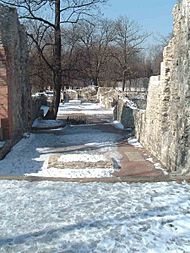
In 1261, Béla and his son Stephen together invaded Bulgaria. They forced the Tzar to leave the Vidin region. Béla returned to Hungary before the campaign ended, and his son continued it.
Béla's favoritism towards his younger son, Béla (who became Duke of Slavonia), and his daughter Anna, made Stephen angry. Stephen thought his father was trying to disinherit him. Stephen often wrote that he had "suffered severe persecution" from his parents. Some fighting happened in the autumn, but a full civil war was avoided. Two archbishops helped Béla and Stephen reach a compromise. In the Peace of Pressburg, they divided the country along the Danube River. Béla ruled the lands west of the river, and Stephen ruled the eastern territories as the junior king.
However, the relationship between father and son remained difficult. Stephen took over his mother's and sister's lands that were in his eastern realm. In 1264, Béla's army, led by Anna, crossed the Danube. She captured Stephen's wife and children. A part of the royal army forced Stephen to retreat to a fortress in Transylvania. But Stephen's supporters rescued the castle, and he launched a counter-attack. In the important Battle of Isaszeg, Stephen defeated his father's army in March 1265.
Again, the two archbishops helped Béla and his son negotiate. Their agreement was signed in the Dominican Monastery on Rabbits' Island (now Margaret Island, Budapest) on 23 March 1266. This new treaty confirmed the division of the country along the Danube. It also set rules for how Béla's and Stephen's parts of the kingdom would work together, including taxes and people's right to move freely.
Last Years (1266–1270)
In 1267, nobles from both Béla's and Stephen's parts of Hungary met in Esztergom. At their request, Béla and Stephen together confirmed their special rights, which were first written down in the Golden Bull of 1222. Soon after, Béla assigned four nobles from each county to check property rights in Transdanubia.
King Stephen Uroš I of Serbia invaded the Banate of Macsó, a region ruled by Béla's widowed daughter, Anna. A Hungarian royal army quickly defeated the invaders and captured Stephen Uroš. The Serbian king had to pay a ransom before he was released.
Béla's favorite son, also named Béla, died in the summer of 1269. On 18 January 1270, the King's youngest daughter, Saint Margaret, also died. King Béla soon became very ill. On his deathbed, he asked his grandson-in-law, King Ottokar II of Bohemia, to help his wife, daughter, and supporters if they had to leave Hungary because of his son. Béla died on Rabbits' Island on 3 May 1270. He was 63, which was older than most kings of his time. He was buried in the Franciscan church in Esztergom.
King Béla IV left his son, Stephen, a strong, rebuilt, and well-fortified kingdom after 28 years. Béla successfully created an alliance between the Árpád dynasty and the Capetian House of Anjou through a marriage agreement. In December 1269, a visitor from Italy, Abbot Bernhard Ayglerius, came to Hungary. He wrote excitedly about Béla's court:
"The Hungarian royal house has incredible power, its military forces are so large that nobody in the East and the North dares even budge if the triumphant and glorious king mobilizes his army. Most of the countries and princes of the North and East belong to his empire by kinship or conquest."
Family
| Ancestors of Béla IV of Hungary | |||||||||||||||||||||||||||||||||||||||||||||||||||||||||||||||||||||||||||||||||||||||||||||||||||||||||||||||||||||||||||||||||||||||||||||||||||||||||||||||||||||||||||||||||||||||||||||||||||||||||||||||||||||||||||||||||||||||||||||||||||||||||||||||||||||||||||||||||||||||||||||||||||||||||||||||||||||||||||||||||||||||||||||||||||||||||||||||||||||||||||||||||||||||||||||||||||||||||||||||||||||||||||||||||||||||||||||||||||||||||||||||||||||||||||||||||||
|---|---|---|---|---|---|---|---|---|---|---|---|---|---|---|---|---|---|---|---|---|---|---|---|---|---|---|---|---|---|---|---|---|---|---|---|---|---|---|---|---|---|---|---|---|---|---|---|---|---|---|---|---|---|---|---|---|---|---|---|---|---|---|---|---|---|---|---|---|---|---|---|---|---|---|---|---|---|---|---|---|---|---|---|---|---|---|---|---|---|---|---|---|---|---|---|---|---|---|---|---|---|---|---|---|---|---|---|---|---|---|---|---|---|---|---|---|---|---|---|---|---|---|---|---|---|---|---|---|---|---|---|---|---|---|---|---|---|---|---|---|---|---|---|---|---|---|---|---|---|---|---|---|---|---|---|---|---|---|---|---|---|---|---|---|---|---|---|---|---|---|---|---|---|---|---|---|---|---|---|---|---|---|---|---|---|---|---|---|---|---|---|---|---|---|---|---|---|---|---|---|---|---|---|---|---|---|---|---|---|---|---|---|---|---|---|---|---|---|---|---|---|---|---|---|---|---|---|---|---|---|---|---|---|---|---|---|---|---|---|---|---|---|---|---|---|---|---|---|---|---|---|---|---|---|---|---|---|---|---|---|---|---|---|---|---|---|---|---|---|---|---|---|---|---|---|---|---|---|---|---|---|---|---|---|---|---|---|---|---|---|---|---|---|---|---|---|---|---|---|---|---|---|---|---|---|---|---|---|---|---|---|---|---|---|---|---|---|---|---|---|---|---|---|---|---|---|---|---|---|---|---|---|---|---|---|---|---|---|---|---|---|---|---|---|---|---|---|---|---|---|---|---|---|---|---|---|---|---|---|---|---|---|---|---|---|---|---|---|---|---|---|---|---|---|---|---|---|---|---|---|---|---|---|---|---|---|---|---|---|---|---|---|---|---|---|---|---|---|---|---|---|---|---|---|---|---|---|---|---|---|---|---|---|---|---|---|---|---|---|---|---|---|---|---|---|---|---|---|---|---|---|---|---|---|---|---|---|---|---|---|---|---|---|---|---|---|---|---|---|---|---|---|---|---|---|---|---|---|---|---|---|---|---|---|---|---|---|
|
|||||||||||||||||||||||||||||||||||||||||||||||||||||||||||||||||||||||||||||||||||||||||||||||||||||||||||||||||||||||||||||||||||||||||||||||||||||||||||||||||||||||||||||||||||||||||||||||||||||||||||||||||||||||||||||||||||||||||||||||||||||||||||||||||||||||||||||||||||||||||||||||||||||||||||||||||||||||||||||||||||||||||||||||||||||||||||||||||||||||||||||||||||||||||||||||||||||||||||||||||||||||||||||||||||||||||||||||||||||||||||||||||||||||||||||||||||

Béla's wife, Maria Laskarina, was born in 1207 or 1208. She died in July or August 1270. Their first child, Kunigunda, was born in 1224. She married Bolesław V the Chaste, Duke of Cracow, in 1246.
A second daughter, Margaret, was born around 1225 but died unmarried before 1242. The third daughter, Anna, was born around 1226. She and her husband, Rostislav Mikhailovich, were very close to Béla. Her great-grandson, Wenceslaus, was King of Hungary from 1301 to 1305.
Béla's fourth daughter, Catherina, also died unmarried before 1242. Next, Elisabeth was born. She married Henry XIII, Duke of Bavaria around 1245. Her son, Otto, was crowned King of Hungary in 1305. Béla's sixth daughter, Constance, married Lev Danylovich around 1251. Béla's seventh daughter, Yolanda, married Bolesław the Pious, Duke of Greater Poland.
Béla's first son, Stephen, was born in 1239 and later became king. Béla's youngest daughter, Margaret, was born during the Mongol invasion in 1242. Her parents dedicated her to God, and she lived her life as a nun in a monastery. The King's youngest son, also named Béla, was born between 1243 and 1250.
Béla's family was known for its holiness. The Church officially recognized three of his daughters as saints: Kunigunda (beatified in 1690), Yolanda (beatified in 1827), and Margaret (canonized in 1943).
The following family tree shows Béla's children and some relatives mentioned in this article.
| Andrew II of Hungary ∞(1)Gertrude of Merania ∞(2)Yolanda de Courtenay ∞(3)Beatrice d'Este |
|||||||||||||||||||||||||||||||||||||||||||||||||
| (1) Béla IV ∞Maria Laskarina |
(1) St Elisabeth |
(1) Coloman, Duke of Slavonia |
(1) Andrew, Prince of Halych |
(1) and (2) two daughters |
(3) Stephen the Posthumous |
||||||||||||||||||||||||||||||||||||||||||||
| St Kunigunda ∞Boleslav V of Cracow |
Margaret | Anna ∞Rostislav Mikhailovich |
Catherina | Elisabeth ∞Henry XIII of Bavaria |
Constance ∞Lev Danylovich |
||||||||||||||||||||||||||||||||||||||||||||
| Blessed Yolanda ∞Boleslav of Greater Poland |
Stephen V of Hungary ∞Elisabeth the Cuman |
Saint Margaret | Béla, Duke of Slavonia ∞Kunigunde of Brandenburg |
||||||||||||||||||||||||||||||||||||||||||||||
Legacy
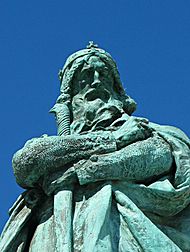
Historian Bryan Cartledge wrote that Béla "reorganized the government, brought back the rule of law, repopulated a ruined countryside, encouraged towns to grow, created the new royal town of Buda, and revived the country's trade." His title, "second founder of the state," shows that people believed he saved Hungary after the Mongol invasion. However, one old book says Béla "was a man of peace, but in battles the least fortunate."
Images for kids
-
Béla's parents—Gertrude of Merania and Andrew II of Hungary—shown in a 13th-century book.
-
Mongols chasing Béla after his defeat in the Battle of Mohi in 1241.
-
The tomb of Frederick the Quarrelsome, Duke of Austria. He died fighting the Hungarians in 1246.
-
Ruins of the Dominican Monastery on Rabbits' Island, where the peace treaty ending the civil war was signed in 1266.
-
A statue of Béla's youngest daughter, Margaret, who became a saint.
-
Béla's statue in Heroes' Square, Budapest.
See also
 In Spanish: Bela IV de Hungría para niños
In Spanish: Bela IV de Hungría para niños


